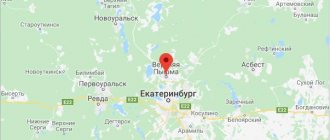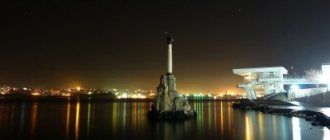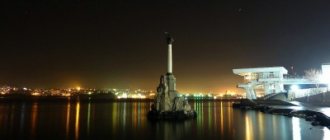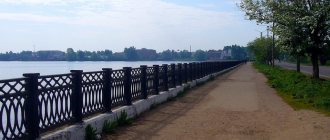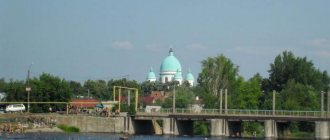From other regions of Russia you can only get to Kamchatka by plane. Flights arriving in this beautiful region land at Elizovo International Airport, Petropavlovsk-Kamchatsky. Flying up to the capital of the region, you can see from above that the city is spread out quite widely on the shore of Avachinskaya Bay, which belongs to the Pacific Ocean. A majestic panorama opens up to your eyes, which will take your breath away: the city surrounded by mountains and water. Very close to Petropavlovsk-Kamchatsky rise the Avachinskaya and Koryakskaya hills, which are active volcanoes.
On the territory of the airport you can see the Li-2 aircraft, turned into a monument. This Soviet military transport ship was actively used in the 40s of the twentieth century, and during the war it worked a lot, transporting cargo. Elizovo was his Kamchatka base.
General information and history
Petropavlovsk-Kamchatsky is a Russian outpost on the Kamchatka Peninsula, a city with a unique history and an even more unique location. The city is located on the shores of the Avachinskaya Bay of the Pacific Ocean, and is at the same time the base of the Russian Pacific Fleet.
View of Petropavlovsk-Kamchatsky from Nameless Volcano
Petropavlovsk-Kamchatsky is one of the oldest cities in the Far East. The first Cossacks arrived here in 1697. Here they founded a fort and laid out storehouses. For more than forty years, no new Russians arrived in Kamchatka, until in 1740 an expedition led by Alexei Chirikov and Vitus Bering on two ships “St. Apostle Paul” and “St. Apostle Peter” arrived to explore Kamchatka. The names of the ships eventually gave the name to the fort. It became Petropavlovsk.
Forty years later, Petropavlovsk was visited by two English warships Discovery and Resolution as part of John Cook's Third Around the World Expedition. Since then, all round-the-world regattas have anchored off the coast of Avacha Bay.
In 1812, the Peter and Paul fort received the status of a city and the name “Peter and Paul Harbor”. In the same year, the sovereign approved the “New Regulations on Kamchatka,” according to which a specially appointed governor-general was to govern the peninsula. Peter and Paul Harbor was chosen as the place for the residence of such a high rank.
View of Petropavlovsk-Kamchatsky
In 1849, the Kamchatka region was formed. The regional center became the Peter and Paul Harbor.
Directly from Petropavlovsk-Kamchatsky to Moscow is 8400 km. The real road would probably be 10,000 km, maybe more. How long would the soldiers march? How long would the carts travel? If the soldiers of central Russia went to rescue their Far Eastern comrades, they would have met a message about the end of the war somewhere in the area of modern Novosibirsk.
Thank God, no one had to help. The Far Easterners showed themselves to be brave warriors and defended the Peter and Paul Harbor in heroic battles. In memory of the brave soldiers, a chapel was erected on Nikolskaya Hill and a mass grave was made.
More than a century and a half later, in 2011, Petropavlovsk-Kamchatsky was declared the “City of Military Glory.” The reward found the hero, it’s just a pity that it’s so late.
18th century engraving depicting Petropavlovsk-Kamchatsky
Climate and ecology of Petropavsk-Kamchatsky
There are not many places in Russia where you can invite tourists. It is not only possible, but also necessary to invite tourists to Kamchatka. The nature here is truly unique. The elevation difference in Petropavlovsk-Kamchatsky itself is 513.6 meters. The lowest point is the level of Avacha Bay. The highest is Mount Rakovaya.
In principle, the entire city stands on hills. There are practically no smooth roads. Constant ups and downs. There are practically no small cars with weak engines here, since they are impossible to drive.
Geographically, Petropavlovsk-Kamchatsky is located south of Moscow, but nevertheless the climate here is much harsher than in the capital. Summer is very cold. It is comparable in average temperatures to Norilsk and Arkhangelsk. Nevertheless, winter on the peninsula is very warm. It is even milder than winter in St. Petersburg. Temperature differences throughout the year are small. In August, the average daily temperature is +12.4 °C, and in January – 7.7 °C below zero. That is, the difference is only 20.1°C.
Precipitation in Kamchatka falls mainly in autumn and winter. In summer, the peninsula is not hot and very comfortable.
The lake inside the Gorely volcano is very similar to the volcanoes located on Easter Island
When talking about the climate of Petropavlovsk-Kamchatsky it is impossible not to mention seismic activity. The eastern coast of the Kuril Islands, Kamchatka and Japan are the most seismically active places on Earth. In the last century, there was one magnitude nine earthquake, two magnitude eight and ten magnitude seven.
The environmental situation in Petropavlovsk-Kamchatsky is quite stable. The air is poisoned mainly by motorists and two local thermal power plants. Since the city has only 181 thousand residents, and only every sixth of them is a motorist, thirty thousand cars are not capable of causing significant harm to the city’s nature.
The water in Achinsk Bay is, of course, dirtier than it was a hundred or even fifty years ago. The reason for this is outdated ships, from which fuel oil regularly leaks. There are no other global environmental problems either in the city or in the region.
Relief
The relief of Kamchatka was formed at the very end of the Cenozoic era. Before this, on the site of the modern peninsula there was a sea, above the surface of which some parts of the modern ridges - the Middle and Eastern - rose in the form of separate islands.
At the beginning of the Quaternary period, intensive mountain-building movements began within the territory of modern Kamchatka. In the process of formation of the region's relief, the role of rivers, which cut deep valleys through the entire territory of the peninsula, is extremely important. Especially deep valleys are confined to high mountain ranges.
In general, Kamchatka is characterized by very deep canyon-like river valleys with a large number of rapids and waterfalls, steep, in some places almost vertical mountain slopes.
Repeatedly, the mountains and lowlands of the Kamchatka Peninsula were covered with powerful glaciers. The traces of the last glaciation, which ended 10-12 thousand years ago, are especially clearly visible. The glaciers began high in the mountains and stretched along river valleys for tens of kilometers. They widened and deepened the valleys they passed through. In the upper reaches of the valleys, in the places where they began, sharp peaks and jagged mountain ridges arose. The glaciers carried out a huge amount of rock fragments, which subsequently formed a very unique hilly topography with a large number of small lakes of various shapes.
Similar terrain with lakes is very common in the region: large areas of it are found on the watershed of the Kamchatka and Bystraya rivers, in the valleys of tributaries of the Avachi rivers and in many others. These places, covered with sun-drenched birch forests with numerous picturesque lakes filled with clean, clear water, are very beautiful.
The largest mountain structures of the peninsula, composed mainly of ancient rocks, are the Sredinny and Eastern ranges.
The median ridge, elongated in a northeast direction, stretches across the entire Kamchatka from the Plotnikova River in the south to the northern tip of the peninsula. Its highest point is the Ichinsky volcano (3621 meters). The relief of the Sredinny Range is diverse. In some places the mountains are very dissected, have sharp ridges and peaks with steep, sometimes sheer walls, which is most typical in the highest part of the ridge. Less high areas are distinguished by a calmer relief: less dissected mountains with flattened watersheds predominate here.
The eastern ridge is less significant. In the south, it begins at approximately the same latitude as Sredinny and extends north to the Ozerny Peninsula on the east coast. It consists of a whole series of smaller ridges that have their own names. In the south, this is the Ganalsky ridge, which in general is the highest and most strongly dissected mountain unit of the peninsula: almost along its entire length, the watershed zone has a height of about 2000 meters and higher, and the depth of the valleys cutting through it reaches 1500 meters. Further to the north is the Valaginsky ridge. It is lower than Ganalsky, but its relief is also strongly dissected. Even further north is the Tumrok ridge. Unlike the previous two, there are many old destroyed volcanoes within its borders. The northern end of the Eastern Range is called the Kumroch Range. This is its lowest part: most of the peaks here barely reach 1000 meters. However, it is here that the highest point of the Eastern Range is located - the ancient, long-extinct Shish volcano (2346 meters).
In the very north of the peninsula lies the Koryak Highlands. It almost everywhere has a calmer topography. Altitudes range from 1000 to 1800 meters. Strongly dissected mountains with jagged ridges and steep slopes are present only in some of the highest areas.
Kamchatka belongs to a zone of active volcanic activity, there are about 300 large and medium-sized volcanoes, 29 of them are active, the total number of potentially active volcanoes is estimated at 36. The largest active volcanoes on the peninsula are Shiveluch, Klyuchevskaya, Ichinskaya, Koryakskaya, Avachinskaya, Karymskaya and Kronotskaya hills, as well as the largest volcano in Eurasia - Klyuchevskaya Sopka (height 4750 meters). There are especially many volcanoes in the southern and eastern parts, as well as in the Sredinny Range. The most ancient volcanoes are so badly destroyed that they can only be identified by the rocks that make them up. The younger ones are much better preserved and have a typical cone shape.
The activity of volcanoes is also associated with the manifestation of hydrogeothermal activity: the formation of fumaroles, geysers, hot springs, etc.
In the Kamchatka Territory there are 3 state reserves, 19 state reserves, 169 unique natural sites, 5 natural parks. 18% of the territory of the Kamchatka Territory is classified as protected. Six specially protected natural areas are included by UNESCO in the List of World Cultural and Natural Heritage, united under the general name “Volcanoes of Kamchatka”.
Population of Petropavsk-Kamchatsky
The indigenous inhabitants of the Kamchatka Peninsula are the Kamchadals, or as they are also called, the Itelmens. From time immemorial, Kamchadals settled along the banks of rivers rich in salmon, fished, and hunted in the forests.
There are very few Kamchadals in the total mass. About 10% of residents of Petropavlovsk-Kamchatsky. The rest of the people are Russians, Ukrainians and Armenians.
The indigenous inhabitants of the peninsula are the Kamchadals
In principle, the population is quite calm. You can walk along the evening streets without fear. The average age of a resident of Petropavlovsk-Kamchatsky is 44 years, with the average life expectancy on the peninsula being 57 years.
There are few young people; after school they move west to larger cities, where they try to stay. The most chic thing is to leave Kamchatka for Moscow. Few people succeed in making such a move. Happiness for many is Khabarovsk and Vladivostok. Krasnoyarsk and Novosibirsk are also considered prestigious cities.
At the moment, more people die in Petropavlovsk-Kamchatsky than are born. The city reached its peak population in 1989, when 286 thousand people lived in Petropavlovsk-Kamchatsky. Now the numbers are much more modest, just over 181 thousand at the beginning of 2021.
Approximately a quarter of residents have higher education. Most often, it is a correspondence course obtained at one of the local branches of universities. In terms of education, city residents are noticeably behind the leading regions of the country and are not leaders even in the Far East.
Natural resources
The flora of Kamchatka includes about 1,200 species of higher plants. At the same time, there is a comparative depletion of the Kamchatka flora in comparison with similar climatic zones of the Far East.
The most common tree species is stone birch or Erman's birch (Betula ermanii), which forms sparse forests. In optimal growing conditions, this is a fairly large tree, up to 15-20 meters in height and 90 centimeters in diameter. However, on the ocean coast, at the upper border of the forest and in the north of the peninsula, due to unfavorable climatic factors, its trunk is often strongly curved and rarely reaches even 10 meters in height.
Less common are large coniferous trees: Okhotsk larch (Larix ochotensis) and Ayan spruce (Picea ajanensis), forming forests mainly in the Kamchatka River valley. Endemic to the peninsula, the graceful fir (Abies gracilis) is found on an area of only about 22 hectares on the eastern coast of Kamchatka. Along the mountain slopes and plateaus, cedar or dwarf cedar (Pinus pumila) and Kamchatka alder (Alnus kamtschatica) are widespread, forming unique dwarf forests over vast areas.
In the floodplains of the rivers, sweet poplar, aspen, hairy alder, choicenia, and Sakhalin willow grow. In the undergrowth in the central and southern regions of Kamchatka there are Asian bird cherry, green-fleshed hawthorn, Kamchatka elderberry, Kamchatka rowan, goat willow and others.
Tall grass is very typical for Kamchatka. Species such as sweet hogweed (Heracleum dulce), Kamchatka meadowsweet (Filipendula camtschatica), bear angelica (Angelica ursina), Kamchatka cacalia (Cacalia kamtschatica), common ostrich (Matteuccia struthiopteris) reach a height of 3-4 meters.
The seas washing Kamchatka are rich in a variety of mollusks (mussel, littorina, whelk, chiton), crustaceans (shrimp, king crab), marine mammals (seal, sea lion, sea otter, walrus, fur seal, killer whale), as well as a large number of fish species (394 species in the Bering Sea and 270 species in the Sea of Okhotsk). The most common are cod, flounder, herring, smelt, greenling or sea lenka, sea bass, slingshot or sea goby, and salmon.
Their land mammals include the Kamchatka sable, ermine, otter, mountain hare, muskrat, fox, elk, reindeer, bighorn sheep, lynx, polar wolf, wolverine, weasel, hemlock, tarbagan, brown bear, etc.
Districts and real estate of Petropavsk-Kamchatsky
From time immemorial there were no districts in Petropavlovsk-Kamchatsky. At the beginning of the twentieth century, no more than a thousand people lived in the city. Of course, decades later the situation changed, but zoning never took root. In 1973, Petropavlovsk-Kamchatsky was divided into Oktyabrsky and Leninsky districts, and in 1988 the districts were abolished.
Map of Petropavlovsk-Kamchatsky
Now the city is divided into microdistricts, which are usually separated from each other by mountains or bodies of water. There are microdistricts “Fourth Kilometer”, “Fifth Kilometer”, “Sixth Kilometer”, Northeast, Horizon, Silhouette, Center. In addition, the city includes nearby villages: Nagorny, Avacha, Zaozerny, Radygino, Dalniy, Khalaktyrka, Mokhovaya, Chapaevka, Zavoiko.
There is no such thing as a central street in Petropavlovsk-Kamchatsky. Karl Marx Avenue and Sovetskaya Street can compete for the right to be called this way. Due to the city's hills and uneven terrain, the city occupies a huge territory, but the buildings are very sparse, so it takes a long time to get to socially significant objects from almost anywhere in Petropavlovsk-Kamchatsky.
Central district of Petropavlovsk-Kamchatsky
Without exaggeration, we can say that Petropavlovsk-Kamchatsky is located in one of the most beautiful places in the world. All around is the ocean, volcanoes, bays, hills. From the balcony of an ordinary house here you can see such beauty that you have never even dreamed of in any five-star resort. With such wonderful nature, Petropavlovsk-Kamchatsky remains one of the ugliest and ugliest cities not only in Russia, but probably in the world. The residents of Petropavlovsk absolutely do not appreciate the beauty in which they live; even their houses look like temporary huts or barracks because of this.
Local residents here sew up the walls with huge metal sheets, this is done because it blows strongly in the rooms located on the windward side. Vetra, by the way, be healthy in Petropavlovsk-Kamchatsky.
In general, there are no normal hotels in the city. The only decent hotel is located half an hour from the city center, among the pine trees. There are no amenities of civilization near the hotel, but there is a submarine base.
Petropavlovsk residents live every day in anticipation of tremors, but they never come. Periodic earthquakes spoil everything for the townspeople. The only positive thing they bring is beautiful bay windows on buildings, but here they are used not for beauty, but for the sake of lateral strength. Each apartment in a Petropavlovsk apartment building has a shockproof ledge with access to a small balcony. People call this ledge and this balcony the captain's bridge.
There are excellent conditions here for skiers, snowboarders, and lugers. There was no such thing as Krasnaya Polyana or the Grand Canyon. We need an active volcano - please. Valley of Geysers? We have it too. But no. Nobody needs anything. Of course, going to the Kamchatka resort will not be a cheap pleasure, but there are moneybags who vacation in Chile and climb the Himalayas. Why don't all these people come to Kamchatka?
If suddenly some crazy traveler ends up in Petropavlovsk-Kamchatsky, then the best place for him to live is to choose the Central Microdistrict, or, for short, the center, since all the city’s most important department stores and shops are concentrated there. It is from here that transport departs to all other settlements.
Where to go: attractions and interesting places
Petropavlovsk-Kamchatsky cannot boast of significant architectural monuments. The buildings here were built mainly in the 60-80s of the last century, so the capital of the region looks like a Soviet city with standard houses, but in an amazing natural setting. The decoration of the houses has a local flavor associated with the climate. For example, these are metal sheets that are used to cover the walls on the side from which the coldest and strongest wind blows. The wind situation in the city is by no means calm, so such precautions are understandable.
Another feature is the so-called “captain's bridges” in the houses. Due to seismic instability, buildings are equipped with shockproof projections. In residential buildings, such a ledge is designed as a small balcony. Such bay windows, having a purely practical meaning, at the same time play an aesthetic role, decorating houses.
Local museums await residents and guests of the city; they are very interesting and introduce different aspects of Kamchatka life. In addition to the joint and art museums, it will be interesting to visit the museums of the Institute of Volcanology and Seismology, as well as the Scientific Institute of Fisheries and Oceanography. The famous Kamchatka salmon has its own separate museum. There is also a volcano museum called Vulcanarium. This is not a complete list. The city also houses exhibition halls, including the Center for Contemporary Art Loft “Park Kultury”.
When the theater season is open, the evening cultural program can be continued in theaters or at the Philharmonic. Cinemas are open daily.
Infrastructure condition
If you imagine Petropavlovsk-Kamchatsky as a big dog, and the city infrastructure as a dog’s paws, then the dog will turn out to be lame. The city has terrible roads. Nobody wants to lay more durable concrete, preferring asphalt to it. Light seismic tremors are common in this area. As a result, the asphalt is always cracked. Where there are cracks, holes eventually appear. Nobody patches holes for a long time. They collect taxes from residents regularly, but do not use them for their intended purpose. Maybe they are building an underground bunker with these funds? Where were all the townspeople able to escape after the end of the world? Unknown.
All utilities in Petropavlovsk-Kamchatsky are very expensive. Electricity costs 3.47 rubles per kilowatt. Hot water - 18 rubles per cubic meter, cold water - 6 rubles. Such prices are explained by the fact that no one wants to receive energy from wind in Kamchatka. The energy of sea tides is also not used in any way. Only thermal power plants remain. City boiler houses cannot cover the entire city. Many microdistricts have their own stokers, where people who did not do well at school work. Stokers create a lot of smoke in the sky and, in unfavorable winds, can blow into someone’s apartment.
The main type of transport in the city is a bus, and a small bus. The bus traffic pattern resembles the sun. All routes depart from the city center, and two more run along the perimeter of Petropavlovsk-Kamchatsky. In fact, for a small city located on a large territory it is very difficult to come up with something more convenient. The grooves, by the way, are very old and often break down, and sometimes they can’t handle the climb uphill.
There are enough kindergartens, as well as schools. At the end of the eighties, there were a hundred thousand more people living in the city and the entire infrastructure was built for them. Now there are even empty kindergartens. This is not Moscow, the vacant premises here are of no interest to anyone. If you walk around the city, you can count several dozen empty buildings.
The sheets used to decorate houses rust over time.
Despite this, real estate in the city is quite expensive. Rent an apartment daily on Khreshchatyk, in Kyiv, costs the same as in Petropavlovsk-Kamchatsky. Kamchatka does not yet reach Moscow prices, but there will be more. A one-room apartment without any frills costs an average of two million rubles in the city. A two-room apartment costs five hundred thousand more, a three-room apartment costs a million.
Enterprises and work in Petropavlovsk-Kamchatsky
The city-forming enterprise of Petropavlovsk-Kamchatsky is the ocean. Without him, no one would have lived here long ago, despite all the beauty. OJSC Kamchatrybprom, Okeanrybflot, the fishing collective farm named after Vladimir Lenin, CJSC Akros and many small companies operate in the seafood market. The entire industry is controlled by the mafia. Now, however, they call themselves businessmen, but some fifteen years ago, when things were still turbulent, these same people shot at each other, trying to grab a bigger piece of the pie.
It’s a shame that most Kamchatka seafood is exported abroad, and imported into Russia already processed. Failure to develop the full range of fish and seafood production and processing is a disservice not only for Petropavlovsk-Kamchatsky, but also for the entire country. During the fishing season, hundreds of fortune seekers come to the city to hire a sailor and set sail. Sailors often undermine their health on these trips, but at the same time earn very good money.
Volcanic eruptions in Petropavlovsk-Kamchatsky are visible even on a bus
Not long ago, the mining industry began to develop in Kamchatka. Gold, platinum, nickel and silver are mined there. Outsiders are not allowed into the mines, since for a month of unskilled labor there you can get more than a hundred thousand rubles, which is a very good amount for Kamchatka.
Attractions
The capital of the Kamchatka Territory cannot boast of any special architectural and historical sights. The main monuments are associated with the discoverers of Kamchatka. In general, the city is not very beautiful. It is further disfigured by the sheets of iron that residents use to insulate the facades of their houses. Metal rusts and creates a feeling of abandonment and dying.
The main attraction of the region is nature. These are active volcanoes, geysers, beautiful landscapes, and the ocean. The landscape is presented almost untouched. Tourists are invited to national parks and nature reserves to see salmon spawning and bears hunting for them, wild rosemary blooming, and the tranquility of autumn landscapes. Guests are also offered skiing: there are several good slopes within the city.
Crime
The most common crimes in Petropavlovsk-Kamchatsky are somehow related to poaching. In the 90s, the “earners” sorted things out among themselves. Since the 2000s, they have been fighting against law enforcement agencies. Unfortunately, the police in Kamchatka are very corrupt and they do not fight all poachers. Those who pay for their peace of mind do not experience any discomfort. The rest sometimes have to sweat, hiding from pursuit.
There have never been any high-profile contract killings in Petropavlovsk-Kamchatsky. Mostly only Mother Nature is stolen or robbed here, so we can summarize that the city, despite all its greyness, is quite calm.
Administrative division
Initially, the small city did not have any division into districts. But during Soviet times, they tried to artificially divide the settlement into three districts. This innovation did not take root, and later the division was cancelled. Today the city consists of microdistricts through which people navigate in space.
The main streets of Petropavlovsk-Kamchatsky are Sovetskaya and Karl Marx Avenue. Many significant objects of the city are grouped around them. But in general, the settlement is very long, which sometimes poses a problem for residents who need to get to some remote places. The population density is 500 people per square meter. km.



